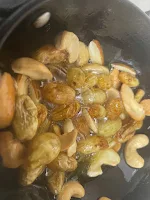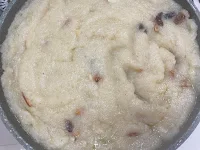Sooji Kesari | Rava Kesari | Bombay Ravva Kesari | Sweet Kesari | Suji Kesari | Easy kesari Recipe | Tasty Ravva Kesari | Indian Sweet Recipes | Semolina Dessert Recipe | South Indian Kesari Recipe | Quick Kesari Recipe | Ghee Kesari | Saffron Kesari | Cashew Kesari | Cardamom kesari | Festive Sweet Recipe | Traditional Indian Dessert | Simple Rava Kesari | Homemade Kesari
- Preparation Time: Approximately 15 minutes
- Cooking Time: Approximately 20 minutes
- Total Time: Approximately 35 minutes
- Servings: This recipe yields approximately 6 servings
1. Introduction:
Rava Kesari is quint essential Indian dessert, adored for its
sweet flavor, aromatic spices, and delightful texture. Originating from the
southern regions of India, this dessert holds a special place in Indian
culinary traditions, particularly during festivals, celebrations, and religious
ceremonies. Its preparation involves simple ingredients like semolina (Bombay
Rava), sugar, ghee (clarified butter), and an assortment of nuts, yet it yields
a dessert that's rich in flavor and steeped in cultural significance.
2. History and Cultural Significance:
Rava Kesari traces its origins to the culinary heritage of South
India, particularly Tamilnadu and Karnataka. Historically, this dessert has
been prepared for centuries as an offering during religious ceremonies and
festivals. It holds deep cultural significance, symbolizing sweetness,
prosperity, and auspicious beginning. In many South Indian households, Rava
Kesari is not only a beloved dessert but also a traditional treat shared among
family and friends during joyous occasions.
3. Importance and Occasions:
The significance of Rava Kesari extends beyond its delicious
taste. It is often prepared during special occasions such as weddings,
birthdays, and religious festivals like Diwali and Navratri its presence on the
dining table signifies celebration, togetherness, and the sharing of blessings.
Whether served as prasad (religious offering) in temples or as a dessert at
home, Rava Kesari adds a touch of sweetness and joy to any occasion.
4. Who Can Enjoy It?
Rava Kesari is a dessert that transcends age and cultural
boundaries. Loved by both young and old alike, it appeals to a wide range of
palates. Its soft, melt-in-your-mouth texture, combined with the crunch of
roasted nuts, makes it a delightful treat for anyone with a sweet tooth.
Whether enjoyed as a post-meal dessert or as a snack with a cup of tea, Rava
Kesari brings joy and satisfaction to those who indulge in its flavors.
5. Benefits and Uses of having this Recipe:
Aside from its delicious taste, Rava Kesari offers several
benefits and uses:
1. Quick and Easy Preparation: With
minimal ingredients and simple cooking techniques, Rava Kesari can be prepared
within a short time frame, making it ideal for busy days or last-minute
entertaining.
2. Versatility: This recipe allows for
customization, such as adjusting the sweetness level according to personal
preference or incorporating different nuts and flavorings to suit individual
tastes.
3. Nutritional-Rich Ingredients: Cashews and raisins,
commonly used in Rava Kesari, provide essential nutrients such as protein
fiber, and health fats, enhancing both the flavor and nutritional value of the
dessert.
6. Ingredients:
1. Cashews-
20g
2. Raisins-
20g
3. Ghee - 3-4 tsp
4. Semolina
(Bombay Rava) - 2 cups
5. Sugar - 2
cups
6. Water - 2
cups
7. Cardamom
Powder - 1 tsp
8. Yellow
Food color (optional)
7. Detailed Cooking Instructions:
1. Roasting the Semolina:
- Begin
by heating a pan over medium heat and adding the semolina (Bombay Rava) to
it.
- Roast the semolina, stirring
constantly, until it turns slightly golden brown in color. Once roasted,
remove it from the pan and set it aside to cool.
2. Preparation of Nuts and Ghee:
- In
the same pan, heat the ghee over medium heat.
- Once the ghee is hot, add the
cashews and roast then until they turn golden brown. Then, add the raisins
and roast them until they plump up.
- Remove the roasted nuts and
raisins from the pan and set them aside.
3. Cooking the Semolina Mixture:
- In
a separate pan, bring the water to a boil.
- While the water is boiling,
gradually add the roasted semolina to it, stirring continuously to prevent
lumps from forming.
- Cook the semolina in the
boiling water until it absorbs the water and thickens to a smooth
consistency.
4. Adding Sugar and Flavorings:
- Once
the semolina is cooked, add the sugar to it and mix well until the sugar
dissolves completely.
- Stir in the cardamom powder to
enhance the flavor of the dish.
5. Final Touches:
- Continue
cooking the mixture over medium heat, stirring continuously, until it
thickens further and reaches the desired consistency.
- Optional: Add a pinch of yellow
food color to the mixture for a vibrant hue.
- Finally, add the roasted nuts
and raisins along with any remaining ghee to the mixture. Mix well to
combine all the ingredients evenly.
6. Serving the Rava Kesari:
- Once
the Rava Kesari is ready, transfer it to individual serving bowls or
plates.
- Garnish with a few saffron
strands or additional nuts for an attractive presentation.
- Serve the Rava Kesari warm or
at room temperature and enjoy its delicious flavors with your loved ones.
8. Cooking Tips and Variations:
1. Proper Roasting of Semolina: To achieve the
perfect texture and flavor, ensure that the semolina is roasted until it turns
slightly golden brown. This process enhances its nutty aroma and prevents it
from becoming lumpy when cooked.
2. Consistent Stirring: While adding semolina to
boiling water, maintain a steady stirring motion to prevent lumps from forming
and to achieve a smooth, lump-free consistency.
3. Adjusting Sweetness: Depending on personal
preference, the amount of sugar can be adjusted to achieve the desired level of
sweetness. For those with a less sweet tooth, reducing the sugar quantity
slightly can still yield a delicious dessert.
4. Enhancing Color: Although optional,
adding a pinch of yellow food color can enhance the visual appeal of Rava
Kesari, giving it a vibrant and inviting hue.
5. Exploring Nut Variations: Experiment
with different nuts such as almonds, pistachios, or walnuts to add variety and
texture to the dessert. Toasting the nuts before adding them to the dish
enhances their flavor and crunchiness.
9. Nutritional Information Per serving (1/6th of the recipe):
- Calories:
Approximately 250
- Fat:
10g
- Carbohydrates:
35g
- Protein:
5g
- Fiber:
2g
- Sugar:
20g
*Note: Nutritional values may vary depending on specific
ingredients used and portion sizes.
10. Presentation and Servings:













Comments
Post a Comment